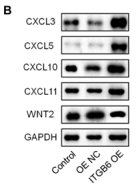CXCL10 Antibody - #DF6417
| Product: | CXCL10 Antibody |
| Catalog: | DF6417 |
| Description: | Rabbit polyclonal antibody to CXCL10 |
| Application: | WB IHC |
| Cited expt.: | WB, IHC |
| Reactivity: | Human, Mouse, Rat |
| Prediction: | Pig, Horse, Rabbit |
| Mol.Wt.: | 10kDa; 11kD(Calculated). |
| Uniprot: | P02778 |
| RRID: | AB_2838380 |
Related Downloads
Protocols
Product Info
*The optimal dilutions should be determined by the end user. For optimal experimental results, antibody reuse is not recommended.
*Tips:
WB: For western blot detection of denatured protein samples. IHC: For immunohistochemical detection of paraffin sections (IHC-p) or frozen sections (IHC-f) of tissue samples. IF/ICC: For immunofluorescence detection of cell samples. ELISA(peptide): For ELISA detection of antigenic peptide.
Cite Format: Affinity Biosciences Cat# DF6417, RRID:AB_2838380.
Fold/Unfold
;Interferon gamma induced factor MOB1, mouse, homolog of; Interferon gamma induced protein 10; 10 kDa interferon gamma induced protein; 10 kDa interferon gamma-induced protein; C X C motif chemokine 10; C7; Chemokine (C X C motif) ligand 10; Chemokine CXC motif ligand 10; Crg 2; CRG2; CXCL10; CXCL10(1-73); CXL10_HUMAN; Gamma IP10; Gamma-IP10; gIP 10; GIP10; IFI10; INP 10; INP10; Interferon activated gene 10; Interferon activated gene 10; Interferon gamma induced cell line; Interferon inducible cytokine IP 10; Interferon inducible cytokine IP10; IP 10; IP-10; Mob 1; MOB1; Protein 10 from interferon (gamma) induced cell line; SCYB10; Small inducible cytokine B10; Small inducible cytokine B10 precursor; Small inducible cytokine subfamily B (Cys X Cys) member 10; Small inducible cytokine subfamily B CXC member 10; Small inducible cytokine subfamily B, member 10; Small-inducible cytokine B10;
Immunogens
A synthesized peptide derived from human CXCL10, corresponding to a region within C-terminal amino acids.
Mainly secreted by monocytes, endothelial cells as well as fibroblasts. Expressed by epithelial cells in thymus (PubMed:11157474). Microglial cells produce CXCL10 in response to viral stimulation (PubMed:12663757).
- P02778 CXL10_HUMAN:
- Protein BLAST With
- NCBI/
- ExPASy/
- Uniprot
MNQTAILICCLIFLTLSGIQGVPLSRTVRCTCISISNQPVNPRSLEKLEIIPASQFCPRVEIIATMKKKGEKRCLNPESKAIKNLLKAVSKERSKRSP
Predictions
Score>80(red) has high confidence and is suggested to be used for WB detection. *The prediction model is mainly based on the alignment of immunogen sequences, the results are for reference only, not as the basis of quality assurance.
High(score>80) Medium(80>score>50) Low(score<50) No confidence
Research Backgrounds
Pro-inflammatory cytokine that is involved in a wide variety of processes such as chemotaxis, differentiation, and activation of peripheral immune cells, regulation of cell growth, apoptosis and modulation of angiostatic effects. Plays thereby an important role during viral infections by stimulating the activation and migration of immune cells to the infected sites (By similarity). Mechanistically, binding of CXCL10 to the CXCR3 receptor activates G protein-mediated signaling and results in downstream activation of phospholipase C-dependent pathway, an increase in intracellular calcium production and actin reorganization. In turn, recruitment of activated Th1 lymphocytes occurs at sites of inflammation. Activation of the CXCL10/CXCR3 axis plays also an important role in neurons in response to brain injury for activating microglia, the resident macrophage population of the central nervous system, and directing them to the lesion site. This recruitment is an essential element for neuronal reorganization (By similarity).
Several proteases can mediate post-secretion cleavages. DPP4 cleaves CXCL10 on its N-terminal 2 amino acids leading to an antagonist form of CXCL10. This dominant negative form is capable of binding CXCR3 but does not induce signaling. MMP9 cleaves 9 amino acids instead.
Secreted.
Mainly secreted by monocytes, endothelial cells as well as fibroblasts. Expressed by epithelial cells in thymus. Microglial cells produce CXCL10 in response to viral stimulation.
Belongs to the intercrine alpha (chemokine CxC) family.
Research Fields
· Environmental Information Processing > Signaling molecules and interaction > Cytokine-cytokine receptor interaction. (View pathway)
· Environmental Information Processing > Signal transduction > TNF signaling pathway. (View pathway)
· Human Diseases > Infectious diseases: Viral > Influenza A.
· Organismal Systems > Immune system > Chemokine signaling pathway. (View pathway)
· Organismal Systems > Immune system > Toll-like receptor signaling pathway. (View pathway)
· Organismal Systems > Immune system > RIG-I-like receptor signaling pathway. (View pathway)
· Organismal Systems > Immune system > Cytosolic DNA-sensing pathway. (View pathway)
· Organismal Systems > Immune system > IL-17 signaling pathway. (View pathway)
References
Application: IHC Species: Mouse Sample: bone tissue
Application: WB Species: Mouse Sample:
Application: WB Species: Human Sample: MMT cells
Application: WB Species: Mouse Sample:
Application: IHC Species: Mouse Sample:
Application: IF/ICC Species: Human Sample: breast cancer tissues
Restrictive clause
Affinity Biosciences tests all products strictly. Citations are provided as a resource for additional applications that have not been validated by Affinity Biosciences. Please choose the appropriate format for each application and consult Materials and Methods sections for additional details about the use of any product in these publications.
For Research Use Only.
Not for use in diagnostic or therapeutic procedures. Not for resale. Not for distribution without written consent. Affinity Biosciences will not be held responsible for patent infringement or other violations that may occur with the use of our products. Affinity Biosciences, Affinity Biosciences Logo and all other trademarks are the property of Affinity Biosciences LTD.






